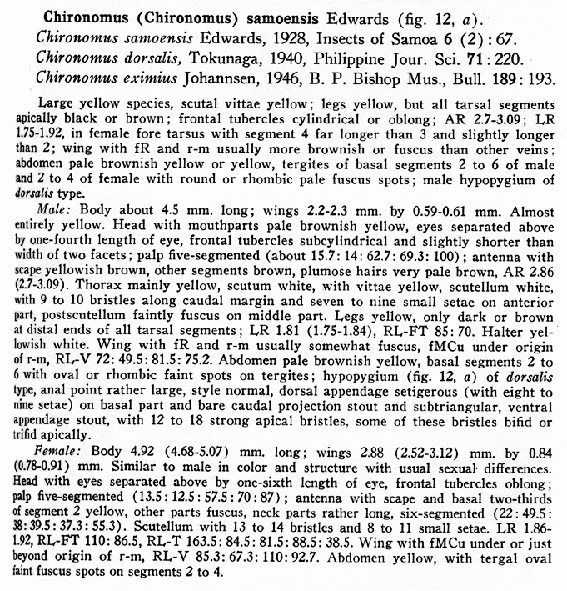Chironomus samoensis Edwards, 1928.
Tokunaga's (1964) description of C. samoensis.
This seems the most reliable description of the adults.

C. samoensis: Male hypopygium (left) and superior appendage (right) (note boot, or shoe, shape)
Males
AR about 2.4 - 2.9.
Frontal tubercles about 33 - 39 µm.
Palp proportions: 44 : 53 : 189 : 222 : 315
Wing length: 2.85 - 3.15 mm; wing width 0.30 - 0.67 mm.
VR about 0.95
Leg lengths (microns) and proportions as follows: | | Fe | Ti | Ta1 | Ta2 | Ta3 | | PI | 1350 | 975 | 1820 | 925 | 837 | | PII | 1305 | 1155 | 750 | 393 | 268 | | PIII | 1478 | 1385 | 1180 | 595 | 448 | | | Ta4 | Ta5 | LR | F/T | BR | | PI | 712 | 362 | 1.82-1.96 | 1.35-1.44 | 1.7-2.2 | | PII | 168 | 125 | 0.62-0.67 | 1.11-1.17 | | | PIII | 262 | 152 | 0.81-0.92 | 1.05-1.09 | | Setae on 9th tergite: 9 - 12 Important features are the LR of about 1.8 - 2.0 (though known range: 1.6 - 1.8) and the relatively long anterior Ta5, which is about 0.35 - 0.4 length of anterior Ti. Pupa: Exuvia length about 7.2 - 7.8 mm. Spur with 1, 2 or sometimes 3 spines.Larva: a medium sized plumosus-type larva (length about 10.7 - 14.3 mm., lab. reared). Anterior ventral tubules (1.24 - 1.84 mm.) shorter than posterior pair (1.40 - 2.28 mm.). Gula pale or very slightly darkened on posterior third; frontoclypeus slightly dark to dark. Mentum (Fig. b) with square sharp teeth, c2 teeth of central trifid tooth well separated from c1 tooth (type IV), 4th laterals slightly reduced (type I). Pecten epipharyngis (Fig. a) with about 16 - 21 variable but sharp teeth. Ventromentum (Fig. c) with about 29 - 34 striae. Antenna (Fig. d) with a moderately long basal segment, which is about 4 - 4.5 times as long as wide; AR about 1.75 - 1.96. Antennal proportions: 122 : 31 : 10 : 13 : 6. Mandible (Fig. e) with third inner tooth only slightly darkened (Type I), and with about 12 - 14 striae at the base. Cytology: 4 polytene chromosomes with the pseudothummi arm combination AE, BF, CD, G.
Nucleolus virtually terminal in arm G; well developed BR about one third from the other end, and a smaller BR close to this other end; closely paired. A nucleolus also occurs about group 19, near the characteristic bands of arm F in Japanese specimens, but not in Australia.
Arm A of Australian specimens differs from that of Japanese specimens by a complex inversion, and arms B and F by simple inversions. Some polymorphism is known within populations (necessarily limited because the Japanese specimens come from a laboratory colony), in arm C.
samA1: 1 - 2c, 10 - 12, 3 - 2d, 9 - 4, 13 - 19 as holomelas(Australia)
samA2: 1a-i, 2k-d, 9e - 4a, 13a - 14i, 3h-i, 12c - 10a, 2c - 1k, 3a-g, 15 - 19 (Japan)
samB1: Puff near the middle of the arm, with dark bands distal.
samC1:
samC2: Small inversion at distal end of the chromosome.
samD1:
samE1: 1 - 3e, 10b - 3f, 10c - 13 as halophilis, etc.
samF1: 1 -2a, 10d-a, 15 - 11, 2b - 9, 16 - 23 (Japan)
samF2: (possibly) 1 - 2a, 10a-d, 15 - 14e, 9 - 2b, 11 - 14d, 16 - 23 (Australia) Chromosome arms A, E and F were described by Wülker et al. (1989) based on Japanese specimens. However, the arm A sequence of Australian specimens is not the same. Found: Type locality - Apia, Western Samoa
Australia - Radon Creek, Kakadu National Park, Northern Territory; 3 km w. Sarina Beach, Queensland
Japan
Micronesia
Indian specimens described by Chattopadhyuy et al. (1991), however, do not appear to be the same species, as the LR is reported as 1.4; the ant. Ta5 is only about 0.25 - 0.28 length of Ti, and the frontal tubercles are only about 18 - 25 micron. It also differs cytologically. This species can be bred in the laboratory, as Japanese specimens have been maintained in a laboratory culture (Elbetieha & Kalthoff 1988) and fertile egg masses were obtained from adults reared from wild collected larvae in Australia.[ Return to Index| Go to Indian "samoensis" ] |

